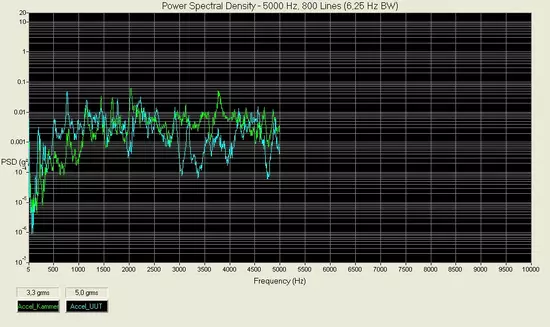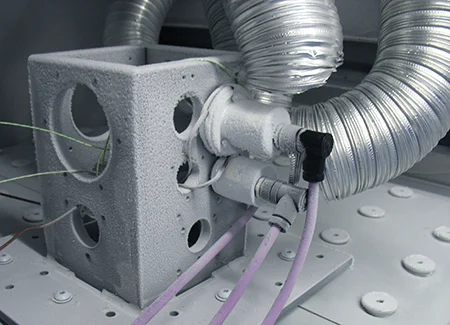
Wachendorff has operated its own HALT testing chamber at its test bay for environmental simulation for several years. The HALT tests (Highly Accelerated Life Test) are an important part of the testing that accompanies development. The following article uses specific examples to describe the testing process for tests that accompany development. As there are no standardised specifications for the HALT test, Wachendorff has modelled its testing process after the "Qualmark HALT Testing Guidelines" [1].

Objective of the tests that accompany development
The objective of the HALT tests is to increase reliability, which can be achieved quickly using accelerated aging.
A product contains different levels of robustness due to its individual components. The HALT test enables initial and other product design flaws to be determined and evaluated for their load levels. This principle is explained by taking a chain as an example.
The HALT test enables an even more reliable product to be brought to market even more quickly.
Classifying the HALT test
The HALT test is run during the development phase. It involves testing the product beyond its specifications to quickly reveal any possible design flaws and to eliminate the need for a re-design in the long term. Unlike design verification testing (DVT), there is no 'pass' or 'fail'. HALT merely reveals any flaws that should subsequently be remedied. The HALT test enables the DVT phase to be completed in one pass and be reduced significantly.


If we observe the level of reliability compared with the failure rate λ, we can see that the HALT test shifts the bathtub curve downwards during the usage phase, which indicates that the failure rate has fallen.
According to the Arrhenius equation, the rule of thumb (for electronics): A temperature increase of 10 °C doubles the failure rate.
For that reason, a markedly quicker aging of the test piece is provoked by applying extreme temperatures.

HALT process
The Wachendorff HALT test process follows the same principle as the HALT procedure. The HALT procedure is broken down into four sections: pre-HALT, HALT testing, post-HALT and verification HALT.
Pre-HALT is the preparations needed for the test (such as defining error criteria, creating function tests). The actual tests are run during HALT testing. The HALT test results are then analysed in the post-HALT phase and optionally a redesign is performed. The HALT testing is then run once again for the redesigned sample to verify the results.

AST chamber
Wachendorff uses an AST chamber (Accelerated Stress Testing) designed by global market-leader Thermotron. As HALT tests are highly intensive and require continuous monitoring by specialist staff, it was clear from the outset that Wachendorff could only successfully run these tests with its own chamber.
- Temperature range: -100 °C up to 200 °C
- Temperature gradient: ≥ 50 K/min
- Vibration: 6 axles (3 translation axles, 3 rotation axles)
- Acceleration: max. 50 gRMS
The AST chamber's test air is heated by an electrical heater to max. 200 °C. The LN2 system (induction of liquid nitrogen) cools the chamber enabling rapid temperature changes. The vibration is created by pneumatic cylinders which impact the test bed from below.


Power Spectral Density (PSD)
PSD is the power spectral density. It describes the quadratic average of an acceleration signal in a certain frequency range. The unit is the acceleration signal divided by the frequency bandwidth (m/s2)2/Hz = gRMS2/Hz. The diagram shows the acceleration signal for a test sample at 5 gRMS (gRMS = quadratic mean of an acceleration signal) of the AST chamber.
Testing sequence

The HALT test is run after an approved test sequence [1]. It enables the thermal and vibration limits of the test pieces to be determined. There are therefore a total of four separate tests:
- Thermal Step Stress Test
- Rapid Thermal Transitions Stress Test
- Vibration Step Stress Test
- Combined Environment Stress Test
During all tests, the stress level is gradually increased and the test continued until a functional disruption/destruction occurs with the test piece, or the technology's limits are reached (e.g. plastic's melting point).
In addition to test piece functionality, visual and other parameters are monitored closely to identify flaws and record them precisely. The function monitoring at Wachendorff takes place for the absolute rotary encoders via the CANopen interface, for example.
At Wachendorff, function tests and statuses are defined on the appropriate encoder. Furthermore, the test piece's functional status is determined by means of pre and post-checks.
Function and destruction limits
During the thermal step stress test, the upper and lower temperature limits are determined, known as the lower and upper operating limits (LOL and UOL). When determining the operating limits, flaws appear that disappear again after the stress reduction. Furthermore, this test determines the temperature limits whereby irreversible defects occur to the test piece. These are known as the lower and upper destruct limits (LDL and UDL).
The vibration step stress test determines the vibration operating limits (VOL) and vibration destruct limit (VDL).
This means that in theory, six limits are determined in total. The focus here is not so much on where a limit lies, but more on why a limit is where it is, i.e. why this limit exists. The higher or lower a limit lies, the more robust the test piece will be when put to productive use. For that reason, Wachendorff does its utmost to test these limits to their extremes.
HALT testing

The absolute rotary encoders are fitted in the AST chamber above a test holder. The test pieces are also fitted with temperature sensors and an acceleration sensor. The AST chamber is controlled to the test piece's temperature. This means that the ambient temperature of the test sample is around 10 °C hotter or cooler than the nominal value.
During the thermal step stress test, the temperature is gradually reduced first of all, and then increased. Once the nominal temperature has been reached, the temperature is maintained for a determined period of time. At Wachendorff, further tests are conducted during this phase to determine the time it takes for the inside of the test piece to reach the nominal temperature. The temperature is increased in line with the LDL or LOL to find out the UDL or UOL.
After that, a temperature change test is run for five cycles with the determined operating limits
(LOL and UOL) for the rapid thermal transitions stress test. The temperature change occurs at at least 50 K/min. The temperature is maintained for a determined period of time for the UOL and LOL.
Furthermore, during the vibration step stress test, the vibrations are gradually increased. Here the vibration is constant for the dwell time for every nominal vibration.
The last test is the combined environment stress test. It involves inflicting the test piece with the temperature change test from the rapid thermal transitions stress test for five cycles. A constant vibration is also applied for every temperature change cycle. The increase of the vibration level per cycle is founded by dividing the determined VDLs by five.
Summary
The WDGA absolute rotary encoder was found to have a lower operating limit of -90 °C and an upper operating limit of 140 °C. The lower destruct limit could not be determined as the AST chamber's limit of -100 °C was reached. The upper destruct limits was +170 °C and is determined by the plastic's melting point.
The vibration operating limit was determined to be 45 gRMS. The vibration destruct limit could not be determined as the AST chamber's limit of 50 gRMS was also reached.
The HALT test, a key element in Wachendorff's testing strategy, therefore confirms the WDGA absolute rotary encoder's robustness and provides Wachendorff and the customer with the knowledge that the product is extremely reliable even under harsh environmental conditions.
Literature
[1] Qualmark Corporation: Qualmark HALT testing guidelines. Test specification, September 2011










